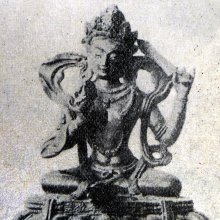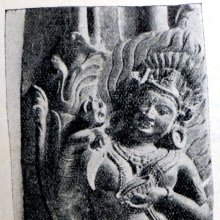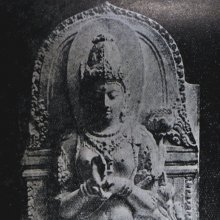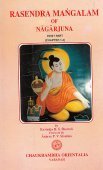Nagarjuna, Nāgārjuna: 25 definitions
Introduction:
Nagarjuna means something in Buddhism, Pali, Hinduism, Sanskrit, the history of ancient India, Marathi. If you want to know the exact meaning, history, etymology or English translation of this term then check out the descriptions on this page. Add your comment or reference to a book if you want to contribute to this summary article.
Images (photo gallery)
(+5 more images available)
In Hinduism
Shaivism (Shaiva philosophy)
Source: Wisdom Library: ŚaivismNāgārjuna (नागार्जुन) is the disciple of Ādinātha: a teacher to whom the Kāpālika doctrine was revelead, mentioned in the Śābaratantra. The Śābara-tantra is an early tantra of the Kāpālika sect containing important information about the evolution of the Nātha sect. It also lists the twelve original Kāpālika teachers and their disciples (eg., Nāgārjuna). Several of these names appear in the Nātha lists of eighty-four Siddhas and nine Nāthas.
Source: academia.edu: Yakṣiṇī-sādhana in the Kakṣapuṭa tantraNāgārjuna (नागार्जुन).—The Kakṣapuṭa-tantra is traditionally attributed to the famous Buddhist philosopher Nāgārjuna. In maedieval India, Nāgārjuna was worshipped as a siddha who was accomplished in various magical sciences, such as rejuvenation and alchemy. We find stories narrating his magical feats in the Buddhist, Hindu, and Jain traditions. Yijing states that Nāgārjuna had extensive knowledge of the vidyādharapiṭaka. The figure of Nāgārjuna as a master of magical sciences seems to have been already established in seventh-century India.

Shaiva (शैव, śaiva) or Shaivism (śaivism) represents a tradition of Hinduism worshiping Shiva as the supreme being. Closely related to Shaktism, Shaiva literature includes a range of scriptures, including Tantras, while the root of this tradition may be traced back to the ancient Vedas.
Yoga (school of philosophy)
Source: Wisdom Library: YogaNāgārjuna is one of the eighty-four Siddhas associated with eighty-four Yogic postures (āsanas), according to popular tradition in Jodhpur, Rājasthān. These posture-performing Siddhas are drawn from illustrative sources known as the Nava-nātha-caurāsī-siddha from Vȧrāṇasī and the Nava-nātha-caruāsī-siddha-bālāsundarī-yogamāyā from Puṇe. They bear some similarity between the eighty-four Siddhas painted on the walls of the sanctum of the temple in Mahāmandir.
The names of these Siddhas (e.g., Nāgārjuna) to 19th-century inscription on a painting from Jodhpur, which is labelled as “Maharaja Mansing and eighty-four Yogis”. The association of Siddhas with yogis reveals the tradition of seeing Matsyendra and his disciple Gorakṣa as the founders of haṭhayoga.

Yoga is originally considered a branch of Hindu philosophy (astika), but both ancient and modern Yoga combine the physical, mental and spiritual. Yoga teaches various physical techniques also known as āsanas (postures), used for various purposes (eg., meditation, contemplation, relaxation).
Purana and Itihasa (epic history)
Source: archive.org: Puranic EncyclopediaNāgārjuna (नागार्जुन).—Minister of King Cirāyus. (For details see under Cirāyus).

The Purana (पुराण, purāṇas) refers to Sanskrit literature preserving ancient India’s vast cultural history, including historical legends, religious ceremonies, various arts and sciences. The eighteen mahapuranas total over 400,000 shlokas (metrical couplets) and date to at least several centuries BCE.
Kavya (poetry)
Source: Wisdom Library: KathāsaritsāgaraNāgārjuna (नागार्जुन) is one of king Cirāyus’s ministers from the city Cirāyus, according to the Kathāsaritsāgara, chapter 41. Accordingly, “he [Cirāyus] had a compassionate, generous and gifted minister, named Nāgārjuna, who was sprung from a portion of a Bodhisattva,[2] who knew the use of all drugs, and by making an elixir he rendered himself and that king free from old age, and long-lived”.
The story of Nāgārjuna and Cirāyus was narrated by Marubhūti in order to demonstrate that “this world of living beings was appointed by the Creator unstable, and full of grief hard to ward off, and even with hundreds of efforts it is impossible for anyone to do anything here which the Creator does not wish him to do”.
The Kathāsaritsāgara (‘ocean of streams of story’), mentioning Nāgārjuna, is a famous Sanskrit epic story revolving around prince Naravāhanadatta and his quest to become the emperor of the vidyādharas (celestial beings). The work is said to have been an adaptation of Guṇāḍhya’s Bṛhatkathā consisting of 100,000 verses, which in turn is part of a larger work containing 700,000 verses.

Kavya (काव्य, kavya) refers to Sanskrit poetry, a popular ancient Indian tradition of literature. There have been many Sanskrit poets over the ages, hailing from ancient India and beyond. This topic includes mahakavya, or ‘epic poetry’ and natya, or ‘dramatic poetry’.
Ayurveda (science of life)
Source: archive.org: Vagbhata’s Ashtanga Hridaya Samhita (first 5 chapters)Nāgārjuna (नागार्जुन) is the author of the Dhūpayogaratnamālā and Aṣṭapadīkṛtadhūpayoga: both of the texts translated by Jārandhara and Monk Rin-chen-bzaṅ-po (Ratnprabha in Sanskrit). This translating team worked together on no less than nine canonical texts dealing with such diverse themes as hymnology, mystics, meditation, discipline, medicine, and chemistry. Besides the Aṣṭāṅgahṛdayasaṃhitā, their list of publications includes [viz., the Nāgārjuna’s Dhūpayogaratnamālā].

Āyurveda (आयुर्वेद, ayurveda) is a branch of Indian science dealing with medicine, herbalism, taxology, anatomy, surgery, alchemy and related topics. Traditional practice of Āyurveda in ancient India dates back to at least the first millenium BC. Literature is commonly written in Sanskrit using various poetic metres.
General definition (in Hinduism)
Source: World Philosophy: HinduismTo historians, Nāgārjuna is among the most enigmatic of philosophers - the date and place assigned to him here are best guesses. Many different works are attributed to him, but there are a handful which seem to be the work of one author. These deeply skeptical works extend the Buddha's deconstruction of the self to deconstruct most of our everyday categories of understanding, in a way that has lent itself to many different interpretations, but has remained foundational to most Mahāyāna Buddhism.
In Buddhism
Tibetan Buddhism (Vajrayana or tantric Buddhism)
Source: Google Books: The Princeton Dictionary of BuddhismNāgārjuna (नागार्जुन) refers to one of the eighty-four Siddhas who biography is contained within the Caturaśītisiddhapravṛtti (or, ‘lives of the eighty-four siddhas’): a 12th-century Sanskrit-original work, whose author (Abhayadattaśrī) is described as “the great guru from Campara in India”. The work contains a series of biographies of eighty-four Siddhas (or, Mahāsiddhas) who obtain various magical powers.
Source: Google Books: Mahāmudrā and Related InstructionsNāgārjuna (नागार्जुन) is the name of an ancient teacher, according to “the succession of Gurus in the Mahāmudrā lineages” in the Kagyü School of Tibetan Buddhism (the Mahāmudrā deals with the nature of the mind).—According to the special Mantrayāna tradition, one lineage is: (1) Vajradhara, (2) Tilopa, (3) Nāropa, and (4) Marpa Lotsāwa. Another lineage is: (1) Vajradhara, (2) Matiratna, (3) Saraha, [(4) Nāgārjuna], (5) Śavaripa, (6) Maitripa, and (7) Marpa Chökyi Lodrö. Afterward, both lineages merge in Lord Milarepa, Lord Daö Shönu [i.e., Gampopa], and so on. This is the lineage of the Kamtsang [Kagyü]. [...]
Source: Wisdomlib Libary: VajrayanaNāgārjuna is the name of a mahāsiddha, of which eighty-four in total are recognized in Vajrayāna (tantric buddhism). His title is “philosopher and alchemist”. He lived somewhere between the 8th and the 12th century AD.
These mahāsiddhas (e.g., Nāgārjuna) are defined according to the Abhayadatta Sri (possibly Abhayākaragupta) tradition. Its textual origin traces to the 11th century caturāsiti-siddha-pravṛtti, or “the lives of the eighty-four siddhas”, of which only Tibetan translations remains. Nāgārjuna (and other Mahāsiddhas) are the ancient propounders of the textual tradition of tantric or Vajrayana Buddhism.
Source: Shodhganga: The Philosophy and Practice in Lakulisa Pasupata order (Buddhism)Nagarjuna is the name of a Buddhist Siddhacarya corresponding with the similarly named Kapalika teacher (according to Sabaratantra).—The interesting overlap between, Buddhist Siddhacaryas teachers of Kapalika sect and Nathas of Natha Sampradyay points at certain similarities between these highly esoteric cults. The fact that the same Siddha [e.g., Nagarjuna] is considered as a Natha and also as a Kapalika teacher talks of a common spiritual tradition followed by these great masters irrespective of the religion they followed or the religion with which they got associated. It throws light on the mutually exclusive nature of spiritual lineages and religion in India.

Tibetan Buddhism includes schools such as Nyingma, Kadampa, Kagyu and Gelug. Their primary canon of literature is divided in two broad categories: The Kangyur, which consists of Buddha’s words, and the Tengyur, which includes commentaries from various sources. Esotericism and tantra techniques (vajrayāna) are collected indepently.
Mahayana (major branch of Buddhism)
Source: Wisdom Library: Maha Prajnaparamita SastraNāgārjuna (नागार्जुन), Āryadeva and Rāhulabhadra represent the first lineage of Madhyamika scholars. Their biographies are legendary and their dates uncertain. Not content with giving us contradictory information on them, the sources confuse them with the siddhas of the same name who were present at Nalandā several centuries later.

Mahayana (महायान, mahāyāna) is a major branch of Buddhism focusing on the path of a Bodhisattva (spiritual aspirants/ enlightened beings). Extant literature is vast and primarely composed in the Sanskrit language. There are many sūtras of which some of the earliest are the various Prajñāpāramitā sūtras.
General definition (in Buddhism)
Source: Buddhist Door: GlossaryA Bodhisattva in South India, born into a Brahman family about 800 years after the Nirvana of Shakyamuni, i.e., 200 AD. He was the founder of Madhyamika (Middle Way) and Sunya (emptiness). He had plenty of writings in Buddhism. He was one of the chief philosophers of Mahayana Buddhism.Source: WikiPedia: BuddhismNāgārjuna (ca. 150–250 CE) is widely considered one of the most important Buddhist philosophers after Gautama Buddha. Along with his disciple Āryadeva, he is considered to be the founder of the Madhyamaka school of Mahāyāna Buddhism. Nāgārjuna is also credited with developing the philosophy of the Prajñāpāramitā sūtras and, in some sources, with having revealed these scriptures in the world, having recovered them from the nāgas (snake-people). Furthermore, he is traditionally supposed to have written several treatises on rasayana alchemy as well as serving a term as the head of Nālandā University.
Source: academia.edu: The Chronological History of BuddhismNagarjuna II (1100-1034 BCE) was the founder of Shunyavada and Madhyamika school of Mahayana Buddhism. Tibetan sources record that Nagarjuna was born in a Brahmana family and received the “siddhi” from the Tara during his stay at Kahora, a part of Kanchi. Nagarjuna proceeded over the Sitavana to Nalendra (Nalanda) where he became a monk and attained the zenith of his knowledge in the five sciences.
The Nagas used to attend Nagarjuna’s sermons at Nalendra (Nalanda) in the form of young boys. They begged him to take up his permanent domicile in the domain of the Nagas which he declined saying that he had to propagate in entire Jambudvipa. He went back to Nalendra with costly presents, with jewels of immense value, and with the religious text called “Nagasahasrika”. Because his connections with the Nagas, he received the name of “Nagarjuna”. After the death of Rahula Bhadra or Saraha Bhadra, Nagarjuna became the head of Nalendra (Nalanda).
India history and geography
Source: What is India: Inscriptions of the ŚilāhārasNāgārjuna (नागार्जुन) is mentioned as the younger brother of Cittarāja: a king from the Śīlāra (Śilāhāra) dynasty, according to the “Ṭhāṇā plates of Mummuṇirāja”. Accordingly, “Thereafter, Cittarāja’s younger brother Nāgārjuna became king—(he) who, resembling Nārāyaṇa in regard to the good fortune of courtesans, was by his anger, the fire of destruction to his arrogant foes. Having heard from afar about the superhuman power of his arms, the itching of the strong arms of his enemies, fond of (fighting on) the battlefield, goes to sleep as it were”.
These copper plates (mentioning Nāgārjuna) were discovered in 1956 while digging the ground between the Church and the District Office at Ṭhāṇā, the chief town of the Ṭhāṇā District in Mahārāṣṭra. Its object is to record the grant, by the Śilāhāra Mummuṇirāja, of some villages and lands to learned Brāhmaṇas on the occasion of the lunar eclipse on the fifteenth tithi of the bright fortnight of Phālguna in the Śaka year 970, the cyclic year being Sarvadhārin.
Source: academia.edu: The Chronological History of Tibetan BuddhismNagarjuna II (11th century BCE).—Though Buddhism was introduced in Tibet during the time of Samantabhadra (16th century BCE) but Acharya Vetalakshema [Garab Dorje] (1321-1221 BCE) was the first teacher of Tibetan Buddhism. It appears that early Tibetan Buddhists followed Indian Buddhist scholars like Nagarjuna II.

The history of India traces the identification of countries, villages, towns and other regions of India, as well as mythology, zoology, royal dynasties, rulers, tribes, local festivities and traditions and regional languages. Ancient India enjoyed religious freedom and encourages the path of Dharma, a concept common to Buddhism, Hinduism, and Jainism.
Languages of India and abroad
Marathi-English dictionary
Source: DDSA: The Molesworth Marathi and English Dictionarynāgārjuna (नागार्जुन).—m S The name of a great monarch yet to appear and to establish an era.
Source: DDSA: The Aryabhusan school dictionary, Marathi-Englishnāgārjuna (नागार्जुन).—m The name of a great monarch yet to appear and to establish an era.
Marathi is an Indo-European language having over 70 million native speakers people in (predominantly) Maharashtra India. Marathi, like many other Indo-Aryan languages, evolved from early forms of Prakrit, which itself is a subset of Sanskrit, one of the most ancient languages of the world.
Sanskrit dictionary
Source: DDSA: The practical Sanskrit-English dictionaryNāgārjuna (नागार्जुन).—Name of an ancient Buddhist teacher of the rank of बोधिसत्त्व (bodhisattva).
Derivable forms: nāgārjunaḥ (नागार्जुनः).
Source: Cologne Digital Sanskrit Dictionaries: Edgerton Buddhist Hybrid Sanskrit DictionaryNāgārjuna (नागार्जुन).—name of a teacher: Mahāvyutpatti 3474; Sādhanamālā 194.17; 267.4.
Source: Cologne Digital Sanskrit Dictionaries: Aufrecht Catalogus CatalogorumNāgārjuna (नागार्जुन) as mentioned in Aufrecht’s Catalogus Catalogorum:—Yogasāra med.
Source: Cologne Digital Sanskrit Dictionaries: Monier-Williams Sanskrit-English DictionaryNāgārjuna (नागार्जुन):—[from nāga] m. Name of an ancient, [Buddhist literature] teacher of the rank of a Bodhi-sattva, [Monier-Williams’ Buddhism 192]
[Sanskrit to German]
Sanskrit, also spelled संस्कृतम् (saṃskṛtam), is an ancient language of India commonly seen as the grandmother of the Indo-European language family (even English!). Closely allied with Prakrit and Pali, Sanskrit is more exhaustive in both grammar and terms and has the most extensive collection of literature in the world, greatly surpassing its sister-languages Greek and Latin.
See also (Relevant definitions)
Starts with: Nagarjunacarita, Nagarjunadeva, Nagarjunajataka, Nagarjunatantra.
Ends with: Siddha nagarjuna, Siddhanagarjuna.
Full-text (+880): Aryadeva, Nagarjuniya, Buddhapalita, Tathagatabhadra, Mahayana, Yogaratnamala, Nagarjunacarita, Nagarjunatantra, Nagarjunajataka, Mahaprajnaparamitashastra, Siddhanagarjunatantra, Aprapti, Siddha nagarjuna, Nagahvaya, Nagarjuni, Nagarjuniyadharmashastra, Kautuhalacintamani, Amritasaralauha, Siddhanagarjuniya, Kakshaputa.
Relevant text
Search found 70 books and stories containing Nagarjuna, Nāgārjuna; (plurals include: Nagarjunas, Nāgārjunas). You can also click to the full overview containing English textual excerpts. Below are direct links for the most relevant articles:
The View From the Center (by Ajahn Amaro)
Mahayana Buddhism and Early Advaita Vedanta (Study) (by Asokan N.)
Chapter 4.1 - Reality in Madhyamika (a): Void the Absolute
Chapter 2.1 - Madhyamika Philosophy
Maha Prajnaparamita Sastra (by Gelongma Karma Migme Chödrön)
Introduction to first volume < [Introductions]
Introduction to fourth volume < [Introductions]
Appendix 9 - Identification of the Dharma teacher ‘Kao Tso’ < [Chapter XIV - Emission of rays]
Bhesajjakkhandhaka (Chapter on Medicine) (by Hin-tak Sik)
A History of Indian Philosophy Volume 2 (by Surendranath Dasgupta)
Part 18 - Āyurveda Literature < [Chapter XIII - Speculations in the Medical Schools]
Part 19 - The Dialectic of Nāgārjuna and the Vedānta Dialectic < [Chapter XI - The Śaṅkara School of Vedānta (continued)]
Part 1 - The World-Appearance < [Chapter XI - The Śaṅkara School of Vedānta (continued)]
Rasa Jala Nidhi, vol 5: Treatment of various afflictions (by Bhudeb Mookerjee)
Part 17 - Chemists of the Metallic School: Nagarjuna < [A Brief History of Indian Chemistry and Medicine]
Part 14 - Chemists of the Metallic School: Shambhu < [A Brief History of Indian Chemistry and Medicine]
Part 11 - Chemists of the Metallic School: Mandavya < [A Brief History of Indian Chemistry and Medicine]
Related products
(+13 more products available)











